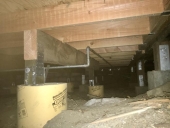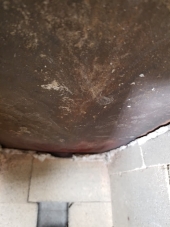


Peter van den Berg wrote:The second suspected flaw is the position of the blast gate. It looks like it's above the level of the riser, this is a tricky position. The temperatures might be too high for the materials of the gate, possibly deforming it.
Daniel Ray wrote:This sounded like a fun question to calculate for my 8" batch. Everything is approximate, I didn't take the time to weigh anything but looked online.
60 full bricks = 240#
60 half bricks = 120#
1 tub high temp mortar = 8#
Fireblanket = 20#
firebox cap ceramic = 20#
secondary air channel = 25#
2 Barrels = 64#
metal door = 10#
So we have approximately 507lbs for an 8" batch without mass. Add in barrels for the bell.
My stove then has about 3 yards of cob at about 1 ton per yard makes my stove 6500 lbs.
thomas rubino wrote:Hi Miguel;
Really, not that much with a batch box/bell.
Certainly much less than building a traditional piped mass with a solid rock and cob filling.
To start, Your core is built of all insulating brick, plus your metalwork, I doubt you would have #100 total.
The rest is all standard clay bricks.
Weigh a single brick and figure out how many you will need.
Add extra for mortar.
With a bell and a bench, your weight will be spread over a large area, easy to support.

thomas rubino wrote:
Raising the mass on hardy board with bricks is foolproof. Plus you gain a heat radiating surface from the bottom.
Yes you also created a great pace for dust bunnys to hide and I guess mice might hide there as well.
No worry's about brick conducting heat to the floor. Your mass will never get very far past 100 degrees especially the further it is from the core.
Peter van den Berg wrote:
Miguel Moreno wrote:Does having a bigger stove, like a 10" mean I have to burn bigger, more frequent fires to get it to work appropriately, even if I don't want want that much heat in the space?
The thing with a batchrocket is this: it can be run with half a load and burn very clean all the same. Even the duration of the burn is about the same as compared to a full load. I am used to long shoulder seasons so I run my heater once in two days or just once just to get the chill out of the house in such a situation.
Short answer: you could do half loads, once per day. A big fat heater could roughly been run once in two days. See it as a sliding scale, nothing to be worried about. Never run the heater for the heater itself, you are the one to be warmed so you are the commanding factor.
For the rest of the house: I'd second Glenn.
Glenn Herbert wrote:A bigger system would mean bigger fires, but not more frequently. As you are in a seriously cold climate with fairly steady heating needs, making the walls of a bell thicker would make the heating more stable and hold heat longer, at the cost of longer lag time before heat makes its way through the walls to your space. If you can fire up the Walker stove for some quicker heat if you really need it, I think I would go with the big fat batch box and expect to usually do fewer fires per day.
Your 317 m3 volume probably translates to around 120 m2 or 1200 square feet, which is not a large house. R-20-25 is fairly modest insulation for a real cold climate, even assuming the roof will be double that. In your situation, I would go with R-60 roof and R-30-40 walls and have less need for heating. Then I expect an 8" batch box plus a Walker stove would take care of you in any weather.
thomas rubino wrote:Hey Miguel;
Having a Walker cook stove makes a difference.
I suggest you build an 8" batch.
Foremost is your chimney 8" or 200mm are widespread and readily available sizes, ten inches is not.
An 8" batch is plenty of stove to share space with a Walker.
Plan on two burns to heat up the whole bell system.

thomas rubino wrote:Hey Miguel;
I consider extreme burning to be back-to-back burns for hours on end.
We burn like that in our uninsulated greenhouse and it remains above freezing all night with no fire.
My shop stove is the same way, a large poorly insulated building.
I burn nonstop when working out there in cold weather.
I used a cast iron roof on the shop stove and although it is still in place and usable it now has a large sag at the hottest part.
In contrast, the factory-made Firebrick tile I have in the greenhouse is as good as the day I installed it.
For longevity, I have found the premade tiles to be the best.
